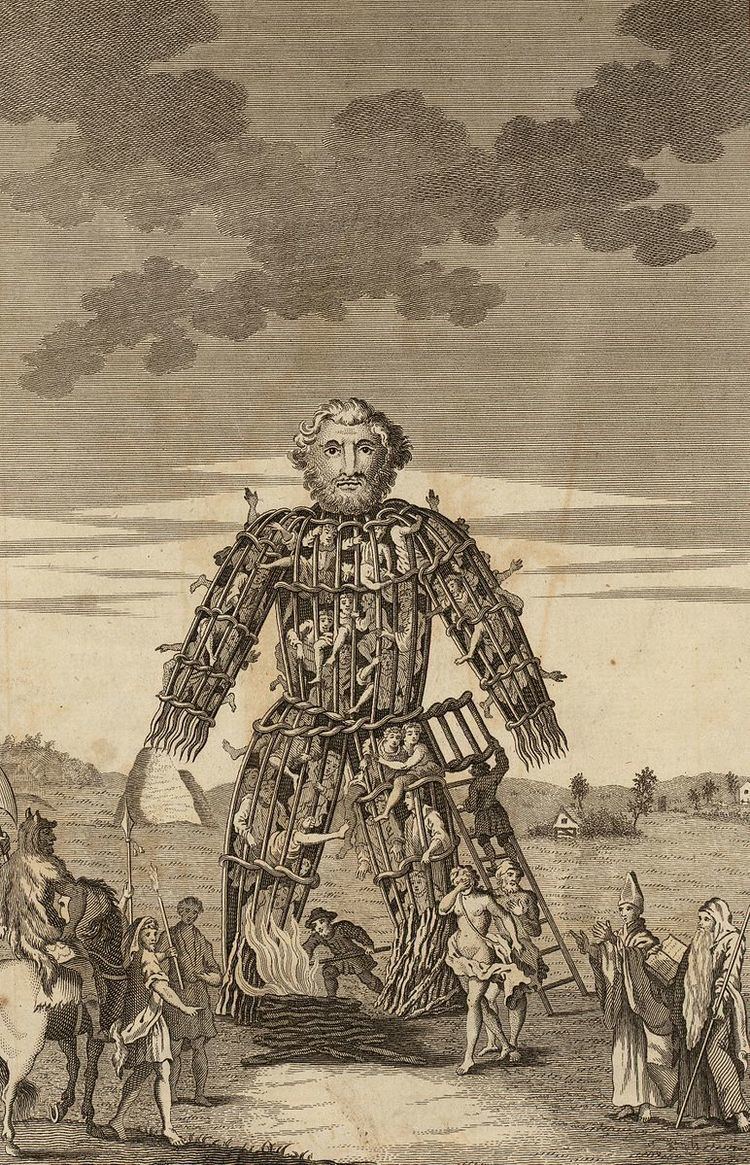 | ||
A wicker man was a large wicker statue reportedly used by the ancient Druids (priests of Celtic paganism) for sacrifice by burning it in effigy, according to Julius Caesar in his Commentarii de Bello Gallico (Commentary on the Gallic War). Contradicting the Roman sources, more recent scholarship finds that "there is little archeological evidence" of human sacrifice by the Celts, and suggests the likelihood that Greeks and Romans disseminated negative information out of disdain for the barbarians. There is no evidence of the practices Julius Caesar described, and the stories of human sacrifice appear to be derived a single source, Poseidonius, whose claims are unsupported.
Contents
Archaeological evidence from the British Isles also indicate that human sacrifice may have been practiced, over times pre-dating any contact with Rome. Human remains have been found at the foundations of structures from the Neolithic time to the Roman era, with injuries and in positions that argue for their being foundation sacrifices.
In some more modern times, wicker men are used for various events. The figure has been adopted for festivals as part of some neopagan-themed ceremonies, without the human sacrifice element. Effigies of this kind have also been used as elements in performance art, as display features at rock music festivals, as thematic material in songs, the idea behind Iron Maiden's song, "The Wicker Man", and as the focal point of the cult British horror film The Wicker Man. Much of the prominence of the wicker man in modern popular culture and the wide general awareness of the wicker man as structure and concept is attributable to this film.
Ancient
While other Roman writers of the time, such as Cicero, Suetonius, Lucan, Tacitus and Pliny the Elder, described human sacrifice among the Celts, only Caesar and the geographer Strabo mention the wicker man as one of many ways the Druids of Gaul performed sacrifices. Caesar reports that some of the Gauls built the effigies out of sticks and placed living men inside, then set them on fire to pay tribute to the gods. Caesar writes that though the Druids generally used those found guilty of crimes deserving death, as they pleased the gods more, they sometimes used slaves and thralls when no delinquents could be found.
One medieval commentary, the 10th-century Commenta Bernensia, states that men were burned in a wooden mannequin in sacrifice to Taranis.
Neopagan usage
Wicker men are set ablaze during some neopagan festivities. A female effigy of wicker or other materials is burnt at the stake for the annual Danish celebration of Sankt Hans aften (Saint John's Eve). Typically, Celtic neopagans, Neo-druids, are those who use such a motif in their festivities because they, unlike other neopagan groups, are either inspired by, or follow a reconstructed form of, Celtic paganism. At other times, neopagans do not burn wicker men, but keep them as idols for protection, often merging them with the Green Man. Neopagan wicker men range from life sized to huge, humanoid, temporary sculptures that are set ablaze during a celebration, usually toward the end of the event. They are constructed with a wooden frame that is woven with flexible sticks such as willow often used in wicker furniture and fencing. Some wicker men are extremely complex and require days of construction.
Modern
The Wickerman Festival is an annual rock and dance music event that takes place in Kirkcudbrightshire, Scotland; its main feature is the burning of a large wooden effigy on the last night.
The Northern Italian version of the wicker man is called La vecchia ("the old lady") which is burned once a year as part of town festivals. However, it has a more Christian connotation since it is burned on Mid-Lent Thursday, as depicted in the film Amarcord by Federico Fellini.
In addition, since 1986, an effigy of a man has been burned during Burning Man, a week-long annual event currently being held in Black Rock Desert, Nevada.
In the Clay animation music video by Radiohead for the song "Burn the Witch", the visitor journalist depicted touring through a strange town gets tricked into climbing up a ladder into a wicker man structure, which then locks him inside and the structure is then set alight with all the townsfolk watching.
